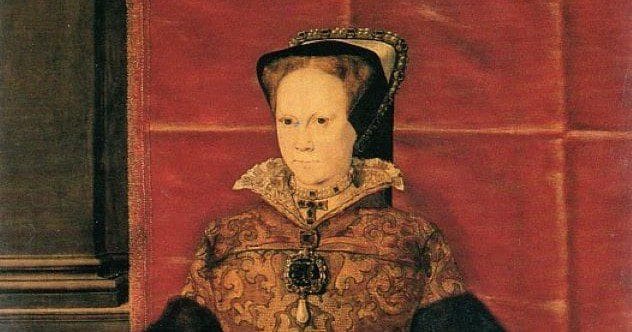Mary I of England often gets a bad rap. As the only surviving child of King Henry VIII and Catherine of Aragon, she ruled during intense religious turmoil. Her efforts to restore Catholicism led to the persecution of Protestants, earning her the chilling nickname ‘Bloody Mary’.
But history isn’t always black and white. Overshadowed by her famous sister, Elizabeth I, Mary’s story is often reduced to just the Marian persecutions. Is that fair? Let’s look beyond the nickname. Here are ten reasons why Mary Tudor might not have been the villain history paints her to be.
10. Born into a Divided Family
Mary’s beginnings were knotted. Her mother, Catherine of Aragon, was a Spanish princess first married to Henry VIII’s older brother, Arthur. When Arthur died young, Catherine eventually married the new heir, Henry VIII. Sounds complicated, right?
Mary arrived in 1516 after several heartbreaking stillbirths and infant deaths. In an era craving male heirs, only Mary survived. This lack of a son gnawed at Henry VIII, ultimately tearing her family apart and setting the stage for future conflict.
9. Traumatized as a Teenager by Her Father
Henry VIII became obsessed with his lack of sons. He convinced himself—or perhaps just pretended—that marrying his brother’s widow was against God’s law and the reason for his heirless state, despite the Pope initially approving the marriage.
He desperately wanted out. When the Pope refused to annul the marriage, Henry took drastic steps. He secretly married Anne Boleyn, declared himself Supreme Head of the Church in England, and crucially, declared his marriage to Catherine invalid. This meant teenage Mary was suddenly illegitimate, stripped of her titles, and removed from the line of succession, all because her father wanted a new wife and a son.
8. Humiliated and Forced to Wait on Her Baby Sister
When Anne Boleyn gave birth to Elizabeth in 1533, Mary’s situation worsened. Now considered illegitimate, she was forced to serve as an attendant to her infant half-sister, the new heir. Adding insult to injury, her mother Catherine was banished from court, and Mary was forbidden contact.
Despite immense pressure, Mary refused for years to accept her illegitimacy or her father’s religious authority, showing remarkable strength. Though she eventually conceded under duress (secretly telling the Pope why), she still showed kindness to Elizabeth, later helping reconcile her with their father after Anne Boleyn’s execution.
7. Spared the Life of Her Usurper
After Henry VIII finally had a son, Edward, with his third wife, Jane Seymour, Mary likely thought her chances of ruling were over. Edward VI did become king, but he died young, childless. Although Henry had put Mary back in the line of succession, the devoutly Protestant Edward, fearing Mary would reverse the Reformation, named his Protestant cousin, Lady Jane Grey, as his successor, bypassing both Mary and Elizabeth.
Jane’s reign lasted only days. Mary rallied support and marched on London. Recognizing Jane was merely a pawn, Mary initially spared her life. Sadly, political maneuvering continued, and Jane was later executed to prevent further plots against Mary’s throne.
6. Courageous and Trailblazing for the Time
Mary lived in a world where women weren’t expected to lead boldly. Yet, her actions often defied convention. Hearing of her brother Edward VI’s impending death, she didn’t wait passively. She fled to safety among loyal supporters, knowing she’d be imprisoned otherwise. It was a decisive, politically smart move essential for securing her claim.
Focusing on her legitimate right as Henry VIII’s eldest heir, rather than religion, she won support from both Catholics and Protestants. Her popular support grew, Jane Grey’s government collapsed, and shortly after Mary took the throne, Parliament confirmed that a queen held the same power as a king, a significant step for female rulers.
5. Guided by the Religious Conventions of Her Time
Burning people at the stake for their beliefs is horrifying to us now. But in the 16th century, religion was seen as the path to eternal salvation, and rulers felt obligated to uphold the ‘true’ faith. Mary, a devout Catholic, genuinely believed her brother’s death was a sign God wanted England back under papal authority.
Becoming queen unexpectedly reinforced these beliefs. To her, allowing Protestantism to continue would be failing her duty to God and her subjects. While the persecution of Protestants was brutal, Mary acted according to the strong religious convictions and expectations of her era, believing she was saving souls by eradicating heresy.
4. No Different from Other Monarchs of the Age
The name ‘Bloody Mary’ suggests unique cruelty. However, harsh punishments, including execution for religious or political reasons, were common among rulers of the time. Her own father, Henry VIII, executed both Catholics and reformers—sometimes by burning—in his tumultuous reign. Estimates suggest he executed tens of thousands.
Even her successor, Elizabeth I, famed for a ‘Golden Age’, ordered hundreds executed after a Catholic uprising and famously had her cousin, Mary, Queen of Scots, put to death. While Mary I’s nearly 300 burnings in five years were significant, they weren’t entirely out of step with the brutal standards of 16th-century European monarchs.
3. Counter-Reformation Was Popular During Her Reign
Because Mary’s attempt to restore Catholicism ultimately failed, we might assume it was widely opposed. But that wasn’t necessarily the case. When Mary ascended the throne, England’s break with Rome was less than 25 years old. Religious identity was still very much in flux, and Catholics likely still outnumbered Protestants.
News of her becoming queen actually sparked spontaneous revivals of Catholic Mass in many areas *before* any official policy changes. Parliament supported her religious agenda, repealing earlier Protestant reforms. Within 18 months, England was officially Catholic again. Had Mary lived longer or produced an heir, the Counter-Reformation might have succeeded.
2. Laid Groundwork for Successor’s Achievements
Mary’s reign is often dismissed as ineffective or solely focused on religion. This overlooks her concrete achievements. While the loss of Calais (an English territory in France) is often cited as a failure, later monarchs lost far larger territories without it defining their legacy.
Mary was a diligent queen. She strengthened the navy, reformed coinage and the militia, supported hospitals, and even established a trading company with Russia. Her updates to the customs system boosted royal income, remaining in place under Elizabeth. She also planned currency reforms that Elizabeth later implemented. These actions helped stabilize England and provided a foundation for future successes.
1. Died Too Soon to Consolidate Her Policies
Despite health issues, Mary deeply desired an heir to secure a Catholic succession. Her marriage to Philip II of Spain in 1554 remained childless. Philip eventually returned to Spain, leaving Mary, which sources suggest deeply affected her, possibly stirring old feelings of abandonment.
Tragically, Mary died after only five years on the throne, likely from uterine cancer or ovarian cysts, during a flu epidemic. She was just 42. Her reign was too short to cement her religious and administrative policies. With no Catholic heir, her Protestant sister Elizabeth took the throne, reversing Mary’s changes and ushering in a new era, which ultimately shaped how Mary’s brief reign was remembered.
As Mary herself chose for her motto, “Truth, the daughter of time.” Perhaps with time, we can see her reign with more nuance.
What do you think? Was Mary Tudor truly ‘Bloody Mary’ or a misunderstood monarch shaped by her turbulent times? Share your thoughts in the comments below!










